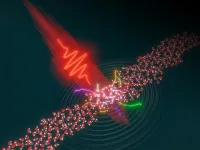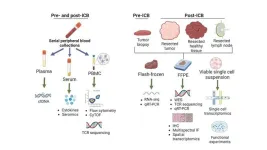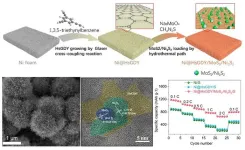Scientists have developed “multielement ink” – the first “high-entropy” semiconductor that can be processed at low-temperature or room temperature. Multielement ink could enable cost-effective and energy-efficient semiconductor manufacturing. The new semiconducting material could accelerate the sustainable production of next-gen microelectronics, photovoltaics, solid state lighting, and display devices. Semiconductors are the heart of almost every electronic device. Without semiconductors, our computers would not be able to process and retain data; and LED (light-emitting diode) lightbulbs would lose their ability to shine.
But semiconductor manufacturing requires a lot of energy. Forming semiconductor materials from sand (silicon oxide) consumes a significant amount of heat-intensive energy, at scorching temperatures of around 2,700 degrees Fahrenheit. And the process of purifying and assembling all the raw materials that go into making a semiconductor can take weeks if not months.
A new semiconducting material called “multielement ink” could make that process significantly less heat-intensive and more sustainable. Developed by researchers from Lawrence Berkeley National Laboratory (Berkeley Lab) and UC Berkeley, “multielement ink” is the first “high-entropy” semiconductor that can be processed at low-temperature or room temperature. The breakthrough was recently reported in the journal Nature.
“The traditional way of making semiconductor devices is energy-intensive and one of the major sources of carbon emissions,” said Peidong Yang, the senior author on the study. Yang is a faculty senior scientist in Berkeley Lab’s Materials Sciences Division and professor of chemistry and materials science and engineering at UC Berkeley. “Our new method of making semiconductors could pave the way for a more sustainable semiconductor industry.”
The advance takes advantage of two unique families of semiconducting materials: hard alloys made of high-entropy semiconductors; and a soft, flexible material made of crystalline halide perovskites.
High-entropy materials are solids made of five or more different chemical elements that self-assemble in near-equal proportions into a single system. For many years, researchers have wanted to use high-entropy materials to develop semiconducting materials that self-assemble with minimal energy inputs.
“But high-entropy semiconductors have not been studied to nearly the same extent. Our work could help to significantly fill in that gap of understanding,” said Yuxin Jiang, co-first author and graduate student researcher in the Peidong Yang group with Berkeley Lab’s Materials Sciences Division and the department of chemistry at UC Berkeley.
Although conventional high-entropy alloy materials require far less energy than silicon to process for manufacturing, they still demand very high temperatures of over 1000 degrees Celsius (or over 1832 degrees Fahrenheit). Scaling up high-entropy materials for industrial-scale manufacturing is challenging because of this enormous energy input.
To overcome this hurdle, Yang and team then leveraged the unique qualities of a well-studied solar material that has intrigued researchers for many years: halide perovskites.
Perovskites are easily processed from solution at low temperature – from room temperature to around 300 degrees Fahrenheit. These lower processing temperatures could one day dramatically reduce energy costs for semiconductor manufacturers.
For the new study, Yang and team took advantage of this lower energy requirement to synthesize high-entropy halide persovskite single crystals from a solution under room temperature or low-temperature (80 degrees Celsius or 176 degrees Fahrenheit) conditions.
Because of their ionic bonding nature, halide perovskite crystal structures require significantly lower energy to form as compared to other material systems, explained Yang.
Experiments at Berkeley Lab’s Advanced Light Source confirmed that the resulting octahedral and cuboctahedral crystals are high-entropy halide perovskite single crystals: one set made of five elements (SnTeReIrPt or ZrSnTeHfPt), and another set made of six elements (SnTeReOsIrPt or ZrSnTeHfRePt). The crystals are approximately 30-100 micrometers in diameter. (A micrometer is one billionth of a meter, which is about the size of a speck of dust.)
The low-temperature/room-temperature technique produces single-crystal semiconductors within hours of mixing a solution and precipitating, far faster than conventional semiconductor fabrication techniques.
“Intuitively, making these semiconductors is like stacking octahedral-shaped molecular ‘LEGOs’ into larger octahedral single crystals,” said Yang. “Imagining each of these individual molecular LEGOs will emit at different wavelengths, one can in principle design a semiconductor material that would emit an arbitrary color by selecting different molecular octahedral LEGOs,” he explained. The authors demonstrated this concept by printing a California Golden Bears logo.
Stability at ambient temperature has long been a problem for advancing commercial-ready halide perovskites, but in a benchtop experiment for the new study, the high-entropy “multielement ink” halide perovskite surprised the research team with an impressive ambient-air stability of at least six months.
Yang said that the multielement ink has a number of potential applications, particularly as a color-tunable LED or other solid-state lighting device, or as a thermoelectric for waste heat recovery. In addition, the material could potentially serve as a programmable component in an optical computing device that uses light to transfer or store data.
“Our high-entropy halide-perovskite semiconductor crystals, with their room-temperature and low-temperature methods, can be incorporated into an electronic device without destroying the other necessary layers, thus allowing for easier design of electronic devices and for more widespread use of high-entropy materials in electronic devices,” said co-first author Maria Folgueras, a former graduate student fellow in the Peidong Yang group at Berkeley Lab and UC Berkeley.
“One can imagine that each of these octahedral LEGOs could carry some type of ‘genetic’ information, just like DNA base pairs carry our genetic information,” Yang said. “It would be quite fascinating if one day we could code and decode these molecular LEGO semiconductors for information science applications.”
The researchers next plan to continue designing sustainable semiconductor materials for solid-state lighting and display applications.
The Advanced Light Source is a user facility located at Berkeley Lab.
This work was supported by the DOE Office of Science.
###
Founded in 1931 on the belief that the biggest scientific challenges are best addressed by teams, Lawrence Berkeley National Laboratory and its scientists have been recognized with 16 Nobel Prizes. Today, Berkeley Lab researchers develop sustainable energy and environmental solutions, create useful new materials, advance the frontiers of computing, and probe the mysteries of life, matter, and the universe. Scientists from around the world rely on the Lab’s facilities for their own discovery science. Berkeley Lab is a multiprogram national laboratory, managed by the University of California for the U.S. Department of Energy’s Office of Science.
DOE’s Office of Science is the single largest supporter of basic research in the physical sciences in the United States, and is working to address some of the most pressing challenges of our time. For more information, please visit energy.gov/science.
END



